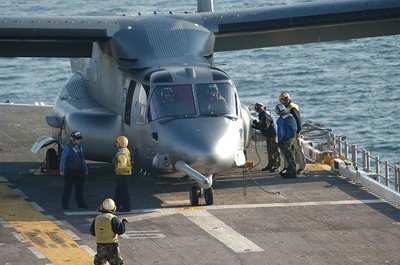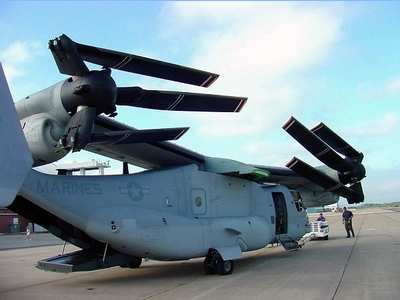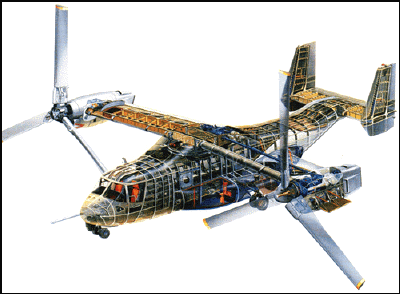The Marine Corps MV-22 Osprey tilt-rotor aircraft completed its
latest series of sea trials last week, using the amphibious assault
ship USS Bataan (LHD 5) as a testing platform. “This was the
final flight deck stability test before the V-22 goes into
production,” said Bataan’s Commanding Officer, Capt.
Earle Yerger. “Since the V-22 will be operating off LHDs and
LHAs, that’s what types of ships were needed for the testing.
We were available and we volunteered.”

The V-22 tilt-rotor is a hybrid of helicopter and airplane and
was designed jointly by Bell Helicopter Textron, Inc. and Boeing
Company. It combines standard aircraft cruise flight with vertical
take-off and landing, and short takeoff and landing capabilities.
Its mission is to support amphibious assaults by transporting
personnel and equipment to a battlefield using high speed and high
altitude to bypass enemy troops and terrain.
According to Lt. Col. Kevin Gross, the government flight test
director for the V-22 Integrated Test Team, the V-22 has twice the
speed and range of the CH-46 Sea Knight helicopter, the aircraft it
will replace, and can carry three times the payload.
“Actually, with our wing tanks, we have almost six times
the range of the CH-46,” said Gross. “We can go 800
nautical miles without refueling. With refueling, we can go 2,200
nautical miles.”
The V-22 was specifically designed to operate from LHD and
LHA-class ships, Gross added.
“It was designed with the required distance between the
rotor and the island, and between the left wheel and the edge of
the ship,” Gross said. “Those are the two constraints
that defined the size of the rotor system, the size of the fuselage
and the capability of the aircraft.”

For pilots and Marines going into combat, the V-22 presents a
whole new set of capabilities. For aircraft handlers like Aviation
Boatswain’s Mate (Handler) Airman Dustin Casey of Air
Department, it presents a new set of challenges.
“Its height and length make it more difficult to spot than
a smaller plane like the Harrier,” said Casey. “We have
to ease it in and out of the spot, and it’s difficult to see
on the other side. It’s sort of like parking a limousine as
opposed to parking an economy car.”
According to Bill Spruce, the lead Bell-Boeing contractor for
the recent testing phase, the purpose of the trials was to verify
the efficiency of new software installed to correct a problem that
came to light during a previous testing sequence.

“We evaluated software in the installed flight control
system to counteract roll tendency that was noted during a previous
phase of testing when airplanes were landing in front of the
V-22,” said Spruce. “In addition, we conducted envelope
expansion testing, to increase the wind-over-deck envelope for
landings and takeoffs. We also obtained downwash measurements to
determine the force of the wind coming off the rotors. Gross
and Spruce both were well pleased with the V-22’s latest
round of sea trials.
“We were just here for a short time to do very focused
tests, and this was just a very small period in our overall flight
test program,” said Gross. “We’re working hard to
make a safe, affordable, reliable aircraft, and every day we fly
it, we gain more and more confidence in it.”
“The testing went very well,” said Spruce.
“The support we received on the Bataan was exceptional, in
every aspect.” [ANN Thanks Journalist 1st Class (SW) Mike
Kramer, USS Bataan Public Affairs]
 ANN FAQ: Submit a News Story!
ANN FAQ: Submit a News Story! ANN's Daily Aero-Term (05.13.25): Cleared For The Option
ANN's Daily Aero-Term (05.13.25): Cleared For The Option Aero-News: Quote of the Day (05.13.25)
Aero-News: Quote of the Day (05.13.25) Aero-News: Quote of the Day (05.14.25)
Aero-News: Quote of the Day (05.14.25) ANN's Daily Aero-Term (05.14.25): Flight Check
ANN's Daily Aero-Term (05.14.25): Flight Check





